Intel Core i9-10850K Review: The Real Intel Flagship
by Dr. Ian Cutress on January 4, 2021 9:00 AM EST- Posted in
- CPUs
- Intel
- Core
- Z490
- 10th Gen Core
- Comet Lake
- LGA1200
- i9-10850K
Gaming Tests: Gears Tactics
Remembering the original Gears of War brings back a number of memories – some good, and some involving online gameplay. The latest iteration of the franchise was launched as I was putting this benchmark suite together, and Gears Tactics is a high-fidelity turn-based strategy game with an extensive single player mode. As with a lot of turn-based games, there is ample opportunity to crank up the visual effects, and here the developers have put a lot of effort into creating effects, a number of which seem to be CPU limited.
Gears Tactics has an in-game benchmark, roughly 2.5 minutes of AI gameplay starting from the same position but using a random seed for actions. Much like the racing games, this usually leads to some variation in the run-to-run data, so for this benchmark we are taking the geometric mean of the results. One of the biggest things that Gears Tactics can do is on the resolution scaling, supporting 8K, and so we are testing the following settings:
- 720p Low, 4K Low, 8K Low, 1080p Ultra
For results, the game showcases a mountain of data when the benchmark is finished, such as how much the benchmark was CPU limited and where, however none of that is ever exported into a file we can use. It’s just a screenshot which we have to read manually.
If anyone from the Gears Tactics team wants to chat about building a benchmark platform that would not only help me but also every other member of the tech press build our benchmark testing platform to help our readers decide what is the best hardware to use on your games, please reach out to ian@anandtech.com. Some of the suggestions I want to give you will take less than half a day and it’s easily free advertising to use the benchmark over the next couple of years (or more).
As with the other benchmarks, we do as many runs until 10 minutes per resolution/setting combination has passed. For this benchmark, we manually read each of the screenshots for each quality/setting/run combination. The benchmark does also give 95th percentiles and frame averages, so we can use both of these data points.

| AnandTech | Low Resolution Low Quality |
Medium Resolution Low Quality |
High Resolution Low Quality |
Medium Resolution Max Quality |
| Average FPS | 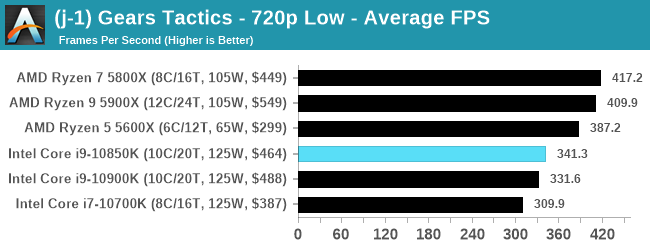 |
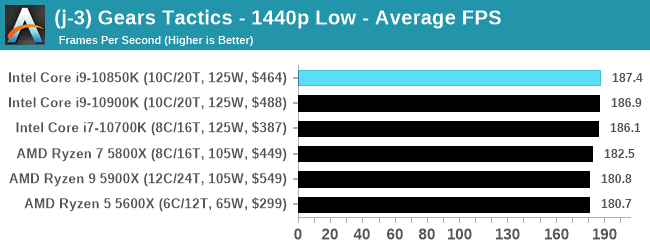 |
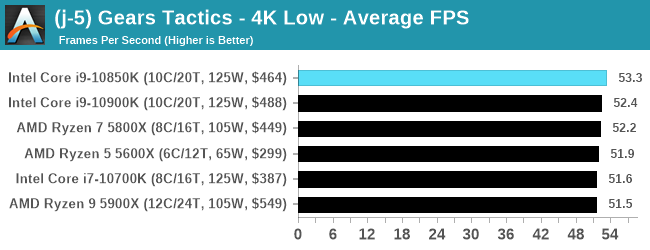 |
 |
| 95th Percentile |  |
 |
 |
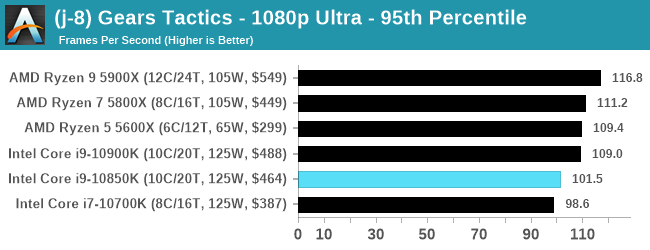 |
All of our benchmark results can also be found in our benchmark engine, Bench.


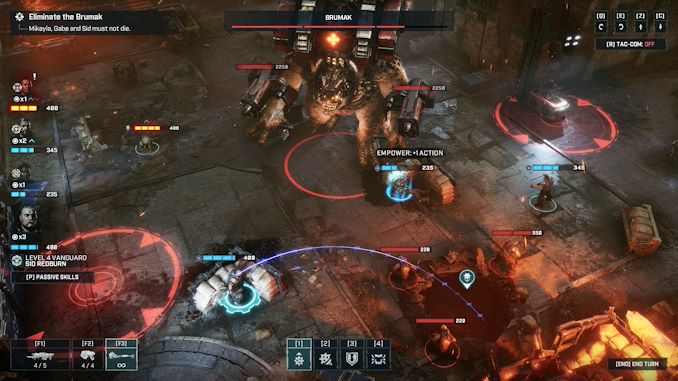








126 Comments
View All Comments
temps - Tuesday, January 5, 2021 - link
Sorry but most of us professionals have moved to Thunderbolt interfaces. How can Ryzen outperform Intel at something it can't support?Qasar - Tuesday, January 5, 2021 - link
so because ryzen doesnt support thunderbolt, the whole platform is slower? thats just stupidtemps - Wednesday, January 6, 2021 - link
I said "outperform" not "slower." Besides, when I built my PC the only AMD that actually was faster than it was the 3900X, which you couldn't buy anywhere at the time. In fact, I still can't get one locally.Zoolook - Wednesday, January 6, 2021 - link
You seem pretty ignorant, there are plenty of am4 motherboards with thunderbolt support.temps - Wednesday, January 6, 2021 - link
What a joke, I can find exactly one officially certified AM4 motherboard and it's mini ITX. Again, we need these for work. I'm not going to run an uncertified, unsupported setup.Qasar - Wednesday, January 6, 2021 - link
zoolook is right, temps, you do seem pretty ignorant if you think just because intel has thunderbolt, it out performs amd, but you dont say how. thunderbolt has nothing to do with how fast a comp is, its a connection interface for external devices, like usb.temps - Wednesday, January 6, 2021 - link
I already said my audio interface needs Thunderbolt... so really, a Celeron outperforms AMD for my requirements. Good job reading. Good day.TheinsanegamerN - Tuesday, January 5, 2021 - link
They did, they were called HDET, and you whined they were too expensive.eastcoast_pete - Monday, January 4, 2021 - link
Thanks and Happy New Year! @Ian and all, one question I had for a while is why Intel or AMD don't use the approach that Qualcomm (with help from ARM and TSMC) started with their 865 SoC? AFAIK, they specifically designed and made one of the four big cores as the core with the highest performance and frequency, and the 888 and others are now using that approach even more formalized by having a single X1 core alongside the 3 A78 big cores. So, is an approach like this - one dedicated high frequency, larger cache etc core plus 5, 7 and 15 others- possible and feasible in x86/x64 CPUs, and if so, why isn't it used? Thanks!Otritus - Monday, January 4, 2021 - link
The windows scheduler was not good enough to properly allocate workloads to the best cores, losing out on performance and efficiency. Intel believes that the scheduler will be good enough when they launch their 12th gen CPUs using Golden Cove and Gracemont cores.